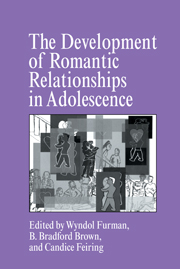Book contents
- Frontmatter
- Contents
- Contributors
- Foreword
- Acknowledgments
- 1 Missing the Love Boat: Why Researchers Have Shied Away from Adolescent Romance
- Part I Processes in Romantic Relationships
- Part II Individual Differences in Romantic Relationships
- 6 Capacity for Intimate Relationships: A Developmental Construction
- 7 Rejection Sensitivity and Adolescent Romantic Relationships
- 8 Sex, Dating, Passionate Friendships, and Romance: Intimate Peer Relations Among Lesbian, Gay, and Bisexual Adolescents
- 9 Gender Identity and the Development of Romantic Relationships in Adolescence
- Part III The Social Context of Romantic Relationships
- Part IV Conclusion
- Author Index
- Subject Index
9 - Gender Identity and the Development of Romantic Relationships in Adolescence
Published online by Cambridge University Press: 05 October 2014
- Frontmatter
- Contents
- Contributors
- Foreword
- Acknowledgments
- 1 Missing the Love Boat: Why Researchers Have Shied Away from Adolescent Romance
- Part I Processes in Romantic Relationships
- Part II Individual Differences in Romantic Relationships
- 6 Capacity for Intimate Relationships: A Developmental Construction
- 7 Rejection Sensitivity and Adolescent Romantic Relationships
- 8 Sex, Dating, Passionate Friendships, and Romance: Intimate Peer Relations Among Lesbian, Gay, and Bisexual Adolescents
- 9 Gender Identity and the Development of Romantic Relationships in Adolescence
- Part III The Social Context of Romantic Relationships
- Part IV Conclusion
- Author Index
- Subject Index
Summary
Gender is obviously a key component for understanding romantic relationships in adolescence. If we listen to the narratives of high school seniors describing particular romantic relationships, our assumptions about expected sex-role-appropriate behavior or constructions may be violated or confirmed.
Person 1: “Um, we're both very easygoing. Um, we like a lot of affection. Um, not like public affection, but um, just knowing that we, we care for each other. Um, uh, it doesn't even have to be physical affection, just any type. We like cuddling with each other. Um, we enjoy going out and doing things with each other and each other's friends. … We enjoy high action things together. Um, pretty much … we have a very open relationship, and we can talk about anything.”
Person 2: “I think after a while like, [person] following me around and wanting to be with me all the time, and maybe the fact that I had a lot to say and had the power … I'd, just like, I don't know, I still think like that. I don't know why but [person] … was getting too serious by following me around all the time and, you know, wanting to spend every minute of the day.
- Type
- Chapter
- Information
- The Development of Romantic Relationships in Adolescence , pp. 211 - 232Publisher: Cambridge University PressPrint publication year: 1999
- 34
- Cited by



